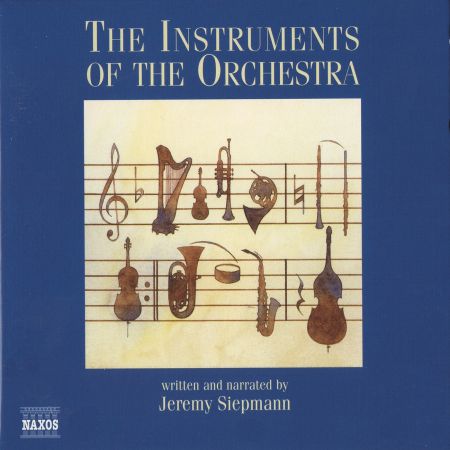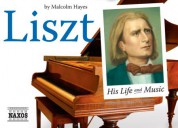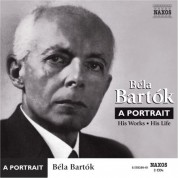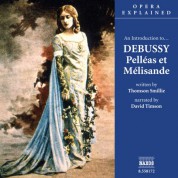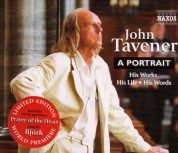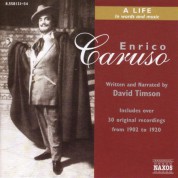Instruments of the Orchestra (The) - CD
Tükendi
Bu Ürün Stoklarımıza Girince Haberdar Olmak İster Misiniz?
(+) Stoklara Girince Haber Ver
(+) Stoklara Girince Haber Ver
Ürün Hakkında
Barkod: 0636943804025
, Katalog No: 8.558040-46 , Firma: Naxos
, Seri: Naxos Educational Products
, Yayınlanma Tarihi:
2 Kasım 2002
Format Türü: CD, Format: 7 CD
Eser Listesi
- CD - 1
- Instruments of the Orchestra
- 1. Wagner: Tannhauser: Overture
- 00:02:06

- 2. Anonymous: Domna, pos vos ay chausida
- 00:00:28

- 3. We don't merely use instruments, we play on them. And they play on us.
- 00:01:19

- 4. Brahms: Hungarian Dance No. 7
- 00:01:39

- 5. The violin is one of the most tender and beautiful instruments ever invented.
- 00:00:45

- 6. Brahms: Violin Concerto in D Major: II. Adagio
- 00:01:08

- 7. But for a long time it was seen as the instrument of the devil.
- 00:00:17

- 8. Stravinsky: The Soldier's Tale: Triumphal March of the Devil
- 00:00:45

- 9. The manipulative seductiveness of the gypsy violin
- 00:00:43

- 10. Anonymous: Csardas Music
- 00:03:33

- 11. The violin and the imitation of nature
- 00:00:23

- 12. Vivaldi: The Four Seasons: Spring: I. Allegro
- 00:00:35

- 13. Birds are again evoked in the second concerto, especially music's natural favourite.
- 00:00:09

- 14. Vivaldi: The Four Seasons: Summer: I. Allegro non molto
- 00:00:41

- 15. Like the devil, the violin is a master of disguise.
- 00:00:18

- 16. Kreisler: Schon Rosmarin
- 00:01:55

- 17. The menacing sensuality of Ravel's Tzigane; a very different side of the violin:
- 00:00:15

- 18. Ravel: Tzigane
- 00:00:51

- 19. Do we now have the true measure of this instrument? Not just yet.
- 00:00:15

- 20. Paganini: Caprice No. 24
- 00:00:48

- 21. Bach: Brandenburg Concerto No. 4: III. Presto / Schubert: Quartettsatz in C Minor
- 00:01:57

- 22. Britten: Variations on a Theme of Frank Bridge: VIII. Moto Perpetuo
- 00:01:06

- 23. Prokofiev's tremolo in Romeo and Juliet should not be heard just before bedtime
- 00:00:22

- 24. Prokofiev: Romeo and Juliet: Act IV
- 00:00:46

- 25. Vivaldi uses it to illustrate the shivering of travellers crossing the ice.
- 00:00:14

- 26. Vivaldi: The Four Seasons: Winter: I. Allegro non molto
- 00:00:57

- 27. The violin muted
- 00:00:31

- 28. Debussy: Clair de lune
- 00:01:41

- 29. The gentleness of muted strings persists even when a whole orchestra plays.
- 00:00:30

- 30. Mozart: Piano Concerto No. 21 in C Major, K. 467: II. Andante
- 00:01:26

- 31. The pizzicato violin
- 00:00:38

- 32. Strauss: Pizzicato Polka
- 00:02:29

- 33. In Prokofiev's Second Violin Concerto, the accompaniment is pizzicato.
- 00:00:26

- 34. Prokofiev: Violin Concerto No. 2 in G Minor: II. Andante assai
- 00:02:02

- 35. Kabalevsky: Colas Breugnon / Warlock: Capriol Suite: III. Tordion / Prokofiev: Romeo and Juliet: Act I
- 00:03:09

- 36. Holst: The Planets: I. Mars: The Bringer of War
- 00:01:27

- 37. Bach: Sonata No. 3 in C Major for unaccompanied violin: II. Fugue
- 00:02:09

- 38. Brahms: Hungarian Dance No. 4
- 00:03:51

- 39. Double-stopping is a standard feature of a lot of folk music.
- 00:00:14

- 40. Vivaldi: The Four Seasons: Autumn: I. Allegro
- 00:00:37

- 41. Now the same technique, but the sound might have come from another world.
- 00:00:30

- 42. Ravel: Bolero
- 00:00:49

- 43. Double-stopping can only approximate the sound of a real violin duet.
- 00:00:20

- 44. Joachim: Cadenza to the Violin Concerto by Brahms
- 00:00:44

- 45. Now compare that with a real violin duet.
- 00:00:12

- 46. Bartok: 44 Duos: I. Teasing Song
- 00:00:52

- 47. Another duo by Bartok, demonstrating the violin's rich lower register
- 00:00:10

- 48. Bartok: 44 Duos: II. Maypole Dance
- 00:00:40

- 49. And now what may be the most beautiful accompanied violin duet in history
- 00:00:17

- 50. Bach: Concerto in D Minor for two violins: II. Largo ma non tanto
- 00:06:43

- 51. The soul of the violin is in song; but what about this weird passage?
- 00:00:42

- 52. Prokofiev: Violin Concerto No. 1 in D Major: II. Scherzo
- 00:00:34

- 53. The use of harmonics in the orchestra can be both magical and unsettling.
- 00:00:29

- 54. Mahler: Symphony No. 1, "Titan": I. Langsam, schleppend (opening)
- 00:01:33

- 55. Tchaikovsky's use of harmonics in The Sleeping Beauty is both strange and daring.
- 00:00:11

- 56. Tchaikovsky: The Sleeping Beauty: Act II, No. 15: Entr'acte
- 00:00:33

- 57. Ravel's harmonics in Mother Goose effect a magical transformation.
- 00:00:29

- 58. Ravel: Ma Mere l'oye (Mother Goose): IV. Beauty and the Beast
- 00:00:36

- 59. Stravinsky: The Firebird: Introduction
- 00:00:32

- 60. The natural upper notes of the violins have a unique emotional "grab"
- 00:00:32

- 61. Strauss: Also sprach Zarathustra: Of the Afterworldsmen
- 00:00:55

- 62. Still in their upper register, the violins unleash the energy of a young colt.
- 00:00:14

- 63. Britten: Variations on a Theme of Frank Bridge: V. Aria Italiana
- 00:01:10

- 64. Elsewhere, Britten uses the same high register to create a very different mood.
- 00:00:11

- 65. Britten: Peter Grimes: 4 Sea Interludes, Op. 33a: I. Dawn
- 00:01:08

- 66. To end this outing with the violins, a charming little elfin dance
- 00:00:12

- 67. Hellmesberger: Elfenreigen
- 00:01:29

- CD - 2
- Instruments of the Orchestra
- 1. Introduction to the viola
- 00:00:42

- 2. Telemann: Viola Concerto: I. Largo
- 00:02:46

- 3. Khachaturian gets a very different sound from it: fuller, fruitier, more exotic.
- 00:00:14

- 4. Khachaturian: Gayane Suite No. 1: III. Armen's Solo
- 00:01:15

- 5. Very nearly the whole of the violin's upper register is also available to the viola.
- 00:00:39

- 6. Britten: Peter Grimes: Passacaglia, Op. 33b
- 00:01:00

- 7. Strauss: Don Quixote
- 00:01:03

- 8. Berlioz: Harold in Italy: IV. Orgy of Brigands
- 00:02:00

- 9. The muted viola: intimate, gentle, poignant in Dvorak
- 00:00:34

- 10. Dvorak: Cypresses: IX. Thou Only Dear One
- 00:03:00

- 11. The massed violas of the modern symphony orchestra in Mahler
- 00:00:40

- 12. Mahler: Symphony No. 4: III. Ruhevoll, poco adagio
- 00:01:13

- 13. The "period" viola in Bach
- 00:01:05

- 14. Bach: Brandenburg Concerto No. 6: III. Allegro
- 00:05:18

- 15. The cello: a voice of unique nobility
- 00:00:28

- 16. Bach: Suite No. 1 for unaccompanied cello: I. Prelude
- 00:02:30

- 17. Brahms and the "soul" of the cello
- 00:00:19

- 18. Brahms: Piano Concerto No. 2 in B-Flat Major: III. Andante
- 00:01:04

- 19. Most orchestral composers tend to emphasise the cello's lower register.
- 00:00:27

- 20. Bach: Herz und Mund und Tat und Leben, BWV 147: Aria: Bereite dir, Jesu
- 00:03:03

- 21. In the time of Beethoven the cello remained as fundamental as ever.
- 00:00:14

- 22. Beethoven: Symphony No. 3 "Eroica": IV. Finale
- 00:00:46

- 23. But the cello is not condemned to spend its life in the basement.
- 00:00:33

- 24. Popper: Elfentanz, Op. 39
- 00:02:55

- 25. Not only in recital showpieces like that is the cello used in its highest register.
- 00:00:10

- 26. Tavener: The Protecting Veil: opening
- 00:02:54

- 27. A cello with an identity-crisis: the pizzicato Flamencan
- 00:00:15

- 28. Tagell: Flamenco
- 00:02:48

- 29. Double-stopping in the lower reaches of the cello's range
- 00:00:31

- 30. Cassado: Solo Suite for Cello and Piano: Sardana
- 00:01:08

- 31. It's in its middle register that the cello really comes into its own.
- 00:00:21

- 32. Rachmaninov: Oriental Dance, Op. 2, No. 2
- 00:01:32

- 33. Beethoven: Symphony No. 5: II. Andante con moto
- 00:00:54

- 34. Beethoven: Symphony No. 9: IV. Finale
- 00:00:54

- 35. Introduction to the double-bass
- 00:00:43

- 36. Saint-Saens: The Carnival of the Animals: The Elephant
- 00:01:32

- 37. But the double-bass can be intensely expressive and graceful.
- 00:00:10

- 38. Bottesini: Elegy No. 1 in D Major
- 00:02:37

- 39. Bottesini: Allegro di concerto, "Alla Mendelssohn"
- 00:00:47

- 40. Bottesini: Capriccio di bravura
- 00:04:42

- 41. Mahler: Symphony No. 1, "Titan": III. Feierlich und gemessen, ohne zu schleppen / Mahler: Symphony No. 3: I. Kraftig
- 00:01:33

- 42. Prokofiev: Lieutenant Kije Suite: III. Kije's Wedding / Prokofiev: Romeo and Juliet: Act III
- 00:02:25

- 43. Beethoven: Symphony No. 5: III. Allegro
- 00:01:20

- CD - 3
- Instruments of the Orchestra
- 1. The antiquity and magic of the flute
- 00:00:20

- 2. Debussy: Prelude a l'apres-midi d'un faune
- 00:03:19

- 3. The versatility and agility of the flute
- 00:00:21

- 4. Bach: Orchestral Suite No. 2 in B Minor: VII. Badinerie
- 00:01:18

- 5. The flute in fifteenth-century Spain
- 00:00:24

- 6. Anonymous: Sa'dawi
- 00:00:55

- 7. Other flutes: the bass and alto
- 00:00:29

- 8. Sallinen: Chamber Music II
- 00:01:12

- 9. The Piccolo - aptly named
- 00:00:19

- 10. Rameau: La Naissance d'Osiris: VI. Premier et deuxieme tambourin
- 00:00:47

- 11. From a piccolo of the eighteenth century to one of its descendants in the twentieth
- 00:00:09

- 12. Stravinsky: Suite No. 2 for Small Orchestra: II. Valse
- 00:00:54

- 13. A variety of techniques
- 00:00:19

- 14. Sallinen: Chamber Music II
- 00:00:31

- 15. Flutter-tonguing. But Tchaikovsky got there eighty years before.
- 00:00:28

- 16. Tchaikovsky: The Nutcracker: Act II, No. 2: Scene
- 00:00:44

- 17. From the transverse to the vertical: the Baroque recorder
- 00:00:40

- 18. Telemann: Recorder Suite in A Minor: Menuet II
- 00:02:12

- 19. An unfamiliar, early vision of the instrument
- 00:00:23

- 20. Baston: Naelden, Naelden
- 00:01:09

- 21. The Bachian oboe
- 00:00:35

- 22. Bach: Ein feste Burg ist unser Gott, BWV 80: Duetto: Wie selig sind doch die
- 00:03:34

- 23. Introduction to the cor anglais or 'English horn'
- 00:00:41

- 24. Dvorak: Symphony No. 9, "From the New World": II. Largo
- 00:01:24

- 25. The loneliness of the cor anglais
- 00:00:11

- 26. Sibelius: The Swan of Tuonela
- 00:01:49

- 27. The cor anglais joins the French horn in Haydn.
- 00:00:17

- 28. Haydn: Symphony No. 22, "The Philosopher": I. Adagio
- 00:01:43

- 29. Introduction to the oboe d'amore, beloved of Bach - but also of Ravel
- 00:00:22

- 30. Ravel: Bolero
- 00:00:50

- 31. Herrmann: The Egyptian: Violence / Janacek: Taras Bulba: The Death of Ostap
- 00:00:37

- 32. Stravinsky: Petrushka: Peasant with Bear / Berlioz: Symphonie fantastique: V. Songe d'une nuit / Prokofiev: Romeo and Juliet: Act II
- 00:01:38

- 33. As the high clarinets tend to be loud, so the bass tends to be soft
- 00:00:18

- 34. Khachaturian: Gayane Suite No. 1: V. Gayane's Solo
- 00:00:54

- 35. Stravinsky: Petrushka: The Blackamoor / Albeniz: Iberia: Almeria
- 00:01:44

- 36. The range of the normal clarinet parts goes quite high...
- 00:00:14

- 37. Tchaikovsky: The Snow Maiden: Scene 5: Melodrama
- 00:01:17

- 38. ....and quite low.
- 00:00:05

- 39. Prokofiev: Peter and the Wolf: The Cat
- 00:00:45

- 40. The clarinet as concerto soloist
- 00:00:19

- 41. Mozart: Clarinet Concerto in A Major: III. Rondo
- 00:02:48

- 42. But that's not the instrument Mozart wrote it for; this is:
- 00:00:16

- 43. Mozart: Clarinet Concerto in A Major: III. Rondo
- 00:02:47

- 44. Introduction to the saxophone
- 00:02:47

- 45. Kodaly: Hary Janos Suite: IV. The Battle and Defeat of Napoleon
- 00:01:03

- 46. The soprano saxophone has quite a different feel to it
- 00:00:09

- 47. Bizet: L'Arlesienne Suite No. 1: II. Minuet
- 00:01:17

- 48. The little sopranino sax goes even higher
- 00:00:12

- 49. Ravel: Bolero
- 00:00:53

- 50. The most famous use of the saxophone is in an orchestration by Ravel
- 00:00:16

- 51. Mussorgsky: Pictures at an exhibition: The Old Castle
- 00:00:55

- 52. The saxophone can be quite contagiously good-humoured.
- 00:00:11

- 53. Wiedoeft: Sax-o-phun
- 00:00:22

- 54. The puffa-puffa image of the bassoon
- 00:00:25

- 55. Prokofiev: Peter and the Wolf: Grandfather
- 00:00:46

- 56. The Bachian bassoon, in accompanimental mode
- 00:00:20

- 57. Bach: Weichet nur, betrubte Schatten, BWV 202, "Wedding Cantata": Aria No. 1
- 00:01:19

- 58. Bizet: Carmen Suite No. 1: V. Les Dragons d'Alcala
- 00:00:56

- 59. And Ravel, also in Spanish mode, does likewise
- 00:00:16

- 60. Ravel: Bolero
- 00:00:59

- 61. The bassoon as a voice of high seriousness, indeed desolate loneliness
- 00:00:15

- 62. Bax: Symphony No. 3: I. Lento moderato
- 00:01:03

- 63. The eerie bassoon in its highest register
- 00:00:15

- 64. Stravinsky: The Rite of Spring: opening
- 00:00:58

- 65. Stravinsky now draws on its lowest register, lonely and melancholy.
- 00:00:21

- 66. Stravinsky: The Firebird Suite (1919): Berceuse
- 00:01:01

- 67. The bassoon as concerto soloist, avoiding all exaggeration
- 00:00:14

- 68. Molter: Bassoon Concerto in G Minor: III. —
- 00:02:02

- 69. The deep-voiced contra-bassoon, as a fairy-tale beast
- 00:00:28

- 70. Ravel: Ma Mere l'oye (Mother Goose): IV. Beauty and the Beast
- 00:01:30

- 71. The French Horn under its woodwind hat
- 00:00:25

- 72. Nielsen: Wind Quintet, Op. 43: III. Praeludium - Tema con variazioni
- 00:01:42

- 73. Now a more prominent role, in a woodwind quintet from an earlier era
- 00:00:12

- 74. Reicha: Wind Quintet in A Minor, Op. 100, No. 5: II. Andante con variazioni
- 00:01:32

- 75. The horn in harmonious blend with strings in another quintet
- 00:00:16

- 76. Mozart: Horn Quintet in E-Flat Major, K. 407: III. Rondeau
- 00:03:55

- CD - 4
- Instruments of the Orchestra
- 1. The Trumpet as virtuoso soloist
- 00:01:02

- 2. Bach: Brandenburg Concerto No. 2: III. Allegro assai
- 00:02:37

- 3. The special brilliance of paired trumpets
- 00:00:19

- 4. Vivaldi: Concerto in C for two trumpets, RV 537: I. Allegro
- 00:02:54

- 5. The ceremonial trumpet
- 00:00:36

- 6. Copland: Fanfare for the Common Man
- 00:01:25

- 7. Trumpets and drums - an incomparable alliance
- 00:00:34

- 8. Handel: Messiah: The Trumpet Shall Sound
- 00:04:10

- 9. The versatility of the trumpet, from the most public to the most lonely
- 00:00:38

- 10. Gershwin: Piano Concerto in F: II. Andante con moto - Adagio
- 00:01:14

- 11. Gershwin: An American in Paris / Stravinsky: The Soldier's Tale: The March
- 00:02:05

- 12. Bizet: Carmen Suite No. 2: II. Habanera
- 00:00:55

- 13. The trumpet as the voice of strength and courage
- 00:00:13

- 14. Bizet: Carmen Suite No. 2: IV. Toreador's Song
- 00:02:20

- 15. Stravinsky: Petrushka: The Blackamoor / Prokofiev: Lieutenant Kije Suite: I. The Birth of Kije
- 00:01:14

- 16. Copland: Billy the Kid
- 00:01:16

- 17. The trumpet as character actor
- 00:00:31

- 18. Mussorgsky: Pictures at an Exhibition: Samuel Goldenberg and Schmuyle
- 00:02:25

- 19. The trumpet as the voice of God
- 00:00:15

- 20. Bach: Mass in B minor: Et expecto
- 00:04:35

- 21. The birth of the trombone
- 00:00:38

- 22. Anonymous: Aenmerckt nu hier
- 00:01:36

- 23. The birth of the brass as a family
- 00:01:24

- 24. Gabrieli: Canzon a 12 in Double Echo
- 00:03:18

- 25. The trombone in the eighteenth century
- 00:00:36

- 26. Albrechtsberger: Trombone Concerto in B-Flat Major: III. Finale
- 00:03:06

- 27. Hoser: Romance for trombone and organ / Berlioz: Requiem: Dies Irae
- 00:02:18

- 28. Liszt: Hosannah, S677/R409
- 00:01:20

- 29. The trombones become part of the orchestra
- 00:00:47

- 30. Beethoven: Symphony No. 5: IV. Allegro
- 00:02:46

- 31. Wagner: Tannhauser: Overture
- 00:01:04

- 32. The Trombone as caricaturist
- 00:00:13

- 33. Stravinsky: Pulcinella: No. 19: Vivo
- 00:01:37

- 34. Bartok: Concerto for Orchestra: IV. Intermezzo interrotto
- 00:01:46

- 35. The horn and the hunt
- 00:00:40

- 36. Mozart: Horn Concerto No. 4 in E flat, K. 495: III. Rondo
- 00:03:39

- 37. The challenging horn of the Baroque
- 00:00:42

- 38. Rameau: Abaris ou les Boreades: II. Menuet
- 00:01:20

- 39. The scarcity of first-rate players in Handel's time
- 00:00:24

- 40. Handel: Water Music: Suite No. 1 in F Major, HWV 348: Menuet
- 00:01:57

- 41. Stravinsky: The Firebird Suite (1919): Finale
- 00:00:59

- 42. Horns and the sound of nobility
- 00:00:12

- 43. Wagner: Tannhauser: Overture (opening)
- 00:00:56

- 44. The special sound of the horn in its higher register
- 00:00:11

- 45. Bach: Mass in B Minor: Quoniam tu solus sanctus
- 00:04:15

- 46. The trumpet-like sound of massed horns
- 00:00:21

- 47. Mahler: Symphony No. 3: I. Kraftig (opening)
- 00:00:38

- 48. The tuba - unfairly maligned?
- 00:00:49

- 49. Prokofiev: Symphony No. 6: III. Vivace
- 00:01:07

- 50. The tuba perfectly cast by Ravel
- 00:00:26

- 51. Mussorgsky: Pictures at an Exhibition: Bydlo
- 00:03:00

- CD - 5
- Instruments of the Orchestra
- 1. Introduction. And we begin with a bang.
- 00:01:02

- 2. Copland: Fanfare for the Common Man / Beethoven: Wellington's Victory, Op. 91 (opening)
- 00:01:03

- 3. At the opposite extreme is the triangle.
- 00:00:26

- 4. Liszt: Piano Concerto No. 1 in E-Flat Major: Scherzo
- 00:01:21

- 5. Categories of percussion: tuned and untuned. The side drum
- 00:00:36

- 6. Rossini: La gazza ladra (The Thieving Magpie): Overture (opening)
- 00:00:52

- 7. Nielsen: Clarinet Concerto (opening)
- 00:01:08

- 8. The tambourine. One of the oldest instruments in the world
- 00:00:21

- 9. Anonymous: Den hoboecken dans
- 00:01:43

- 10. Even older is the originally oriental gong.
- 00:00:28

- 11. Ravel: Ma Mere l'oye (Mother Goose): Laideronette
- 00:01:00

- 12. Britten: Peter Grimes: Passacaglia, Op. 33b
- 00:01:00

- 13. Satie: Gymnopedie No. 2
- 00:01:02

- 14. Elgar: The Sanguine fan / Cymbals clashed softly / Cymbals struck singly / Cymbals stroked with wire brushes
- 00:01:28

- 15. Ravel: Piano Concerto in G Major (opening) / Tchaikovsky: The Nutcracker: Act I Scene 5
- 00:01:05

- 16. Wood blocks
- 00:00:31

- 17. Copland: Rodeo: IV. Hoe-Down
- 00:00:44

- 18. Glinka: Jota aragonesa
- 00:01:09

- 19. Monteverdi: Scherzi musicali: Damigella tutta bella
- 00:01:50

- 20. A still earlier example from fifteenth-century Spain
- 00:00:30

- 21. Traditional: Yo m'enamori d'un aire
- 00:01:06

- 22. The birth of the bongo
- 00:00:33

- 23. Bernstein: West Side Story (Symphonic Dances)
- 00:01:39

- 24. Verdi: II Trovatore: Act II: Anvil Chorus
- 00:01:08

- 25. Grofe: Grand Canyon Suite: III. On the Trail / Varese: Arcana
- 00:01:27

- 26. Moncayo: Huapango
- 00:01:20

- 27. Onwards to the tuned percussion. First, the timpani
- 00:00:14

- 28. Strauss: Also sprach Zarathustra: Introduction
- 00:01:48

- 29. Mahler: Symphony No. 2, "Resurrection'": III. In ruhig fliessender Bewegung
- 00:00:29

- 30. Grofe: Grand Canyon Suite: I. Sunrise / Berlioz: Symphonie fantastique: V. Songe d'une nuit de Sabbat
- 00:00:37

- 31. Taking advantage of tunability
- 00:00:22

- 32. Bartok: Music for Strings, Percussion and Celesta: II. Allegro
- 00:02:25

- 33. Shchedrin: Carmen Suite: IV. Changing of the Guard
- 00:01:01

- 34. Shchedrin: Carmen Suite: V. Carmen's Entrance and Habanera
- 00:01:15

- 35. Saint-Saens and the xylophone
- 00:00:16

- 36. Saint-Saens: The Carnival of the Animals: Fossils
- 00:01:18

- 37. Ravel and the xylophone
- 00:00:11

- 38. Ravel: Ma Mere l'oye (Mother Goose): Laideronette
- 00:02:37

- 39. Shchedrin: Carmen Suite: III. First Intermezzo
- 00:00:38

- 40. Introducing the vibraphone
- 00:00:20

- 41. Steiner: The Treasure of the Sierra Madre: Narange dolce
- 00:01:25

- 42. Shchedrin: Carmen Suite: V. Carmen's Entrance and Habanera
- 00:00:57

- 43. Introducing the Hungarian cimbalom
- 00:00:23

- 44. Traditional: Folk Dances
- 00:03:00

- 45. The cimbalom and the symphony orchestra
- 00:00:10

- 46. Kodaly: Hary Janos Suite : III. Song
- 00:01:30

- 47. Introducing the tubular bells
- 00:00:17

- 48. Kodaly: Hary Janos Suite: II. Viennese Musical Clock
- 00:02:04

- 49. A more "up-front" approach from Rodion Shchedrin
- 00:00:06

- 50. Shchedrin: Carmen Suite: I. Introduction
- 00:01:08

- 51. Vaughan Williams: Symphony No. 7, "Sinfonia antartica": I. Prelude
- 00:00:38

- 52. Introducing the celesta
- 00:00:14

- 53. Tchaikovsky: The Nutcracker: Dance of the Sugar Plum Fairy
- 00:02:10

- 54. Magic, in the use of collective percussion
- 00:00:19

- 55. Ravels: Miroirs: V. La vallee des cloches
- 00:01:39

- 56. Shchedrin: Carmen Suite: VI. Scene
- 00:01:25

- 57. Tchaikovsky: The Nutcracker: Act II: Scene / Liszt: Hungarian Rhapsody No. 1
- 00:01:16

- 58. The traditionally subservient role of the harpsichord in the Baroque orchestra
- 00:00:48

- 59. Bach: Brandenburg Concerto No. 2: II. Andante
- 00:03:11

- 60. Saint-Saens: Symphony No. 3, "Organ": II. Allegro moderato
- 00:01:28

- 61. Stravinsky: Petrushka: Russian Dance
- 00:01:28

- 62. The anti-Romantic piano as an integral part of the orchestra
- 00:00:23

- 63. Bartok: Music for Strings, Percussion and Celesta: IV. Allegro molto
- 00:05:06

- CD - 6
- Instruments of the Orchestra
- 1. Keyboard instruments in the orchestra - the most powerful of them all:
- 00:00:18

- 2. Saint-Saens: Symphony No. 3, "Organ": II. Presto
- 00:01:49

- 3. But things in Handel's day were very different.
- 00:00:15

- 4. Handel: Organ Concerto in B-Flat Major, Op. 4, No. 3: IV. Gavotte
- 00:03:44

- 5. The organ is difficult to classify.
- 00:00:24

- 6. An unexpected, organ-related guest
- 00:00:14

- 7. Boismortier: Concerto pour Zampogna: III. Allegro
- 00:00:14

- 8. Peasant-fancying… and a touch of the roaming cowboy
- 00:00:40

- 9. Schoenberg: Les Miserables: Drink with Me
- 00:01:02

- 10. Mozart: German Dance, K. 603, No. 3
- 00:01:16

- 11. Mahler: Symphony No. 4: I. Bedachtig, nicht eilen
- 00:00:47

- 12. Mahler: Symphony No. 6, "Tragic": I. Heftig, aber markig
- 00:00:53

- 13. Anderson: The Typewriter / Satie: Parade
- 00:02:46

- 14. Varese: Integrales / Gershwin: An American in Paris / Anderson: Sandpaper Ballet
- 00:02:35

- 15. Vaughan Williams: Symphony No. 7, "Sinfonia antartica": I. Prelude
- 00:01:42

- 16. Strauss: Don Quixote: Variation VIII
- 00:01:13

- 17. Rodrigo: Concierto de Aranjuez: III. Allegro gentile
- 00:00:56

- 18. Seeger / Hays: Washington Breakdown
- 00:00:19

- 19. Steiner: The Treasure of the Sierra Madre: Packing Up
- 00:00:18

- 20. Prokofiev: Romeo and Juliet: Act II: No. 14
- 00:00:13

- 21. Steiner: The Treasure of the Sierra Madre: EI Desayuno
- 00:00:18

- 22. The bongos and the congas and a whole wealth of other drums from Africa and Central America
- 00:00:26

- 23. Evening Raga: Bhapoli
- 00:00:17

- 24. Ferre: Paris cancaille
- 00:00:20

- 25. Karas: The Third Man: Theme
- 00:00:25

- 26. Traditional: Folk Dances
- 00:00:21

- 27. Albeniz: Rondena
- 00:01:20

- 28. Traditional: Svetit Mesiats
- 00:01:02

- 29. Vaughan Williams: Symphony No. 7, "Sinfonia antartica": I. Prelude
- 00:01:27

- 30. Debussy: Nocturnes: III. Sirenes
- 00:04:15

- 31. Instruments and the imitation of nature. The clarinet as cuckoo
- 00:01:46

- 32. Saint-Saens: The Carnival of the Animals: The Cuckoo
- 00:01:46

- 33. The flute as an all-purpose aviary
- 00:00:14

- 34. Saint-Saens: The Carnival of the Animals: The Aviary
- 00:01:08

- 35. The oboe as duck
- 00:00:36

- 36. Prokofiev: Peter and the Wolf: The Duck
- 00:01:55

- 37. The recording of reality. Does it work as well?
- 00:00:12

- 38. Respighi: The Pines of Rome: III. The Pines of the Janiculum
- 00:01:17

- 39. The recording of reality electronically reborn in new guises
- 00:00:32

- 40. Rautavaara: Cantus Arcticus, "Concerto for Birds and Orchestra": II. Melankolia (Melancholy)
- 00:01:12

- 41. Beethoven turns avian: cuckoo, nightingale, and quail
- 00:00:26

- 42. Beethoven: Symphony No. 6, "Pastoral": II. Szene am Bach
- 00:01:12

- 43. Some importable casting: the violin as braying donkey
- 00:00:33

- 44. Saint-Saens: The Carnival of the Animals: Persons with Long Ears
- 00:00:47

- 45. A truly orchestral hee-haw to be reckoned with
- 00:00:09

- 46. Mendelssohn: A Midsummer Night's Dream: Overture
- 00:00:29

- 47. A thunderstorm in a million
- 00:00:17

- 48. Beethoven: Symphony No. 6, "Pastoral": IV. Gewitter, Sturm
- 00:03:57

- 49. The instrumental depiction of a silent world
- 00:02:07

- 50. Saint-Saens: The Carnival of the Animals: The Aquarium
- 00:02:20

- 51. Saint-Saens' menagerie takes a curtain call
- 00:00:24

- 52. Saint-Saens: The Carnival of the Animals: Finale
- 00:02:09

- CD - 7
- Instruments of the Orchestra
- 1. The grouping of instrumental families. An additive approach. First, two violins.
- 00:01:20

- 2. Bartok: 44 Duos: IV. Midsummer Night Song
- 00:00:47

- 3. A greater contrast, of both pitch and character, violin and viola
- 00:00:27

- 4. Mozart: Duo for Violin and Viola in B-Flat Major, K. 424: finale: variations 1 and 2
- 00:02:18

- 5. Arrival at the standard string trio: violin, viola and cello
- 00:00:12

- 6. Schubert: String Trio in B-Flat Major: III. Menuetto
- 00:01:09

- 7. The string quartet: two violins, viola and cello
- 00:00:12

- 8. Beethoven: String Quartet in F Major, Op. 18, No. 1: III. Scherzo
- 00:01:53

- 9. The string quintet - when the extra instrument is a second viola
- 00:00:30

- 10. Mozart: String Quintet No. 5 in D Major, K. 593: II. Adagio
- 00:02:21

- 11. The string quintet - when the extra instrument is a second cello
- 00:00:19

- 12. Schubert: String Quintet in C Major: III. Scherzo
- 00:02:12

- 13. The string sextet: two violins, two violas, and two cellos
- 00:00:16

- 14. Brahms: String Sextet No. 1 in B-Flat Major: II. Andante ma moderato
- 00:01:27

- 15. The string octet: the standard string quartet times two
- 00:00:20

- 16. Mendelssohn: Octet in E-Flat Major, Op. 20: movement 1
- 00:02:16

- 17. Double the string octet: a fully fledged string orchestra
- 00:00:15

- 18. Mendelssohn: String Symphony No. 2: III. Allegro vivace
- 00:02:12

- 19. The massed strings of a symphony orchestra
- 00:00:37

- 20. Vaughan Williams: Fantasia on a Theme of Thomas Tallis
- 00:02:58

- 21. Contrasts of pitch and instrumental 'colour' in the woodwind section
- 00:00:44

- 22. Reicha: Wind Quintet in A Minor, Op. 100, No. 5: Theme
- 00:01:10

- 23. In the First Variation it's the horn that gets the lion's share
- 00:00:05

- 24. Reicha: Wind Quintet in A Minor, Op. 100, No. 5: Variation 1
- 00:01:28

- 25. In Variation Two the torch is handed to the bassoon
- 00:00:07

- 26. Reicha: Wind Quintet in A Minor, Op. 100, No. 5: Variation 2
- 00:01:08

- 27. In Variation Three the oboe leads
- 00:00:13

- 28. Reicha: Wind Quintet in A Minor, Op. 100, No. 5: Variation 3
- 00:01:12

- 29. Variation Four: conversation before returning to a solo-dominated texture
- 00:00:07

- 30. Reicha: Wind Quintet in A Minor, Op. 100, No. 5: Variation 4
- 00:01:17

- 31. And Variation Five is dominated by the clarinet
- 00:00:04

- 32. Reicha: Wind Quintet in A Minor, Op. 100, No. 5: Variation 5
- 00:01:12

- 33. The next to be featured is the virtuoso flute.
- 00:00:07

- 34. Reicha: Wind Quintet in A Minor, Op. 100, No. 5: Variation 6
- 00:01:22

- 35. Individual farewells and a closing chorus
- 00:00:19

- 36. Reicha: Wind Quintet in A Minor, Op. 100, No. 5: Variation 7
- 00:00:40

- 37. A mixed group: clarinet, bassoon, horn, string quartet, and double-bass
- 00:00:19

- 38. Schubert: Octet in F Major, D. 803: III. Trio
- 00:02:01

- 39. The early classical symphony orchestra of Haydn and Mozart
- 00:00:34

- 40. Mozart: Symphony No. 29 in A Major, K. 201: IV. Allegro con spirito
- 00:03:32

- 41. Strings, wind, but no brass. What Haydn and Mozart never knew
- 00:00:34

- 42. Gabrieli: Canzon 28
- 00:01:39

- 43. Beethoven's Fifth: two horns, two trumpets, and three trombones join the team
- 00:00:58

- 44. Beethoven: Symphony No. 5: IV. Allegro
- 00:04:28

- 45. From Beethoven to the massive orchestras of Berlioz, Wagner, and Mahler
- 00:00:27

- 46. Beethoven changed the face of the symphony and the orchestra forever.
- 00:00:47

- 47. Mahler: Symphony No. 6, "Tragic": I. Heftig, aber markig
- 00:01:44

- 48. The cult of orchestral elephantiasis reaches its peak
- 00:01:04

- 49. Brian: Symphony No. 1, "Gothic": VI. Te ergo quaesumus
- 00:01:43

- 50. When large doesn't necessarily mean loud: Debussy
- 00:01:10

- 51. Debussy: Images: I. Gigues
- 00:01:50

- 52. A crisis of confidence; the orchestra's survival hangs in the balance, but it still develops. The ondes martenot:
- 00:02:41

- 53. Messiaen: Turangalila Symphony: II. Chant d'amour I
- 00:01:14

- 54. The advent of the "early music" movement brings a new vitality and freshness
- 00:00:57

- 55. Lully: Ballet de Xerxes: Gavotte en rondeau
- 00:00:47

- 56. Computer and synthesiser: friends or foes?
- 00:01:35

- 57. Bach: Concerto in D Minor for two violins: II. Largo ma non tanto
- 00:02:13

- 58. Bach: Mass in B Minor: Dona nobis pacem
- 00:03:24

Katkıda Bulunanlar
|
Bu Ürünler İlginizi Çekebilir

